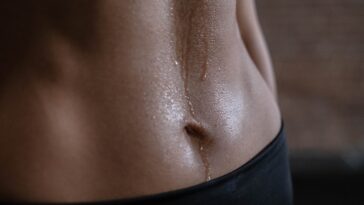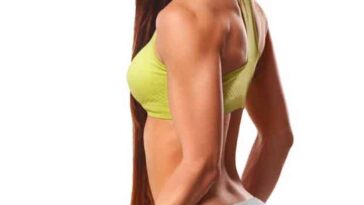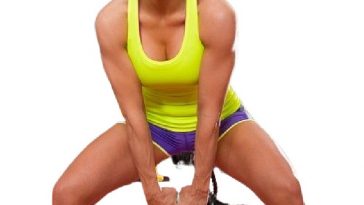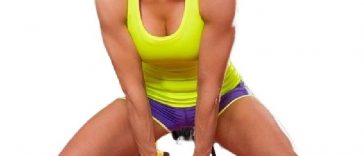Standing Ab Workout
You can achieve strong abs without getting down on an exercise mat. Get super flat abs fast with moves that hit the right angles with the standing ab workout.
Scroll Below To See Full Instructions Along With Our Printable PDF For The Standing Ab Workout
1) Featuring 4 exercises
2) Instructions on how to perform each exercise
3) Infographic with visual instructions to follow online
4) Print PDF available at the end of the infographic
DUMBBELL SIDE BEND
STANDING CORE STABILIZATION
DUMBBELL BOW EXTENSION
REVERSE DUMBBELL CHOP
Do 10 reps per exercise.
Are Dumbbell Exercises for Abs Effective?
Dumbell exercises that target the abs are highly effective in targeting and strengthening the core muscles. When incorporated correctly, these exercises can significantly amplify the results of traditional core workouts.
For those seeking a comprehensive guide, we have a Dumbbell Exercises for Abs PDF that you can easily download to get detailed instructions and visual demonstrations.
Key reasons for their effectiveness include:
Added Resistance: By introducing dumbbells into core workouts, you provide additional resistance to the muscles. This added weight challenges the rectus abdominis and oblique muscles, promoting greater muscle growth and strength.
Versatility of Movements: Dumbbells allow for a variety of movements that can be tailored to target different areas of the core. For instance, with straight arms, palms facing forward, you can slowly twist to the side to work on the obliques. Alternatively, with elbows bent, you can perform weighted crunches that target the upper and middle part of the abs.
Leg and Arm Positioning: The positioning of your arms and legs during dumbbell exercises can be adjusted to vary the intensity. With straight legs or a leg bent, different sections of the core are engaged, allowing for a comprehensive workout that hits every part of the abdominal region.
Enhanced Engagement: Holding a dumbbell, especially with straight arms or elbows bent, requires careful balance and stability This means that even the deepest core muscles get activated, ensuring full core engagement with each repetition.
How To Safely Perform Dumbbell Side Bends for Beginners
Dumbbell side bends are an excellent exercise to engage your obliques and even your hop flexors when done correctly. However, it’s essential to maintain proper form, especially for beginners, to ensure safety and maximize effectiveness.
Here are a few tips:
Starting Position– Stand with your feet shoulder-width apart, with the left foot slightly in front of the right foot. This staggered stance provides a stable base. Make sure both feet are flat on the ground, with the weight evenly distributed.
Grip and Posture- Hold a dumbbell in your right hand, letting it hang at your side. Your left hand can either be on your hip, extended out at shoulder height, or for an added challenge, holding a dumbbell overhead. Maintain an upright posture with your chest up and eyes forward.
Bending Motion– Begin by pushing your hips slightly to the left side, allowing the weight of the dumbbell in your right hand to guide you into a side bend. As you lower the dumbbell, ensure that you’re bending directly to the side and not forward or backward. Your movement should be controlled and limited to just a few inches. Avoid any jerky or swift motions.
Engage the Core– While bending, engage your obliques, especially on the left side, to control the movement. Ensure that your hip flexors are not doing most of the work; the focus should be on the obliques. The slight bend in your right leg will help stabilize the motion.
How To Do The Dumbbell Side Bend
1) Place your feet shoulder width apart.
2) Stand straight holding a dumbbell in both hands.
3) While keeping your back straight and your head up, bend at the waist to the right as far as possible.
4) Breathe in as you bend to the side. Hold your position for a second and exhale as you return to the starting position.
5) Repeat for the recommended amount of repetitions.
6) Repeat for the opposite side.
Common Mistakes to Avoid
Overextending the Movement
A common error while performing dumbbell side bends is bending too far to the side which can strain the upper and lower body, especially the spine. It’s crucial to maintain control throughout the movement, ensuring that you only bend to a point where you feel a stretch in the obliques, not discomfort in the spine.
Incorrect Leg Positioning
Keeping the knees bent or placing too much weight on the left leg (or opposite leg of the hand holding the dumbbell) can lead to an unbalanced stance, making the exercise less effective and potentially causing injury. Instead, stand with your feet shoulder-width apart and keep your weight evenly distributed between both legs.
Engaging the Upper Body Incorrectly
While the primary focus of the dumbbell side bend is on the obliques, some people mistakenly involve their upper body too much. Rolling the shoulder blades forward or using the upper body to lift the dumbbell, rather than relying on the obliques, reduces the effectiveness of the exercise on the target muscles.
Using Excessive Weight
Just as with other weight ab exercises, using a dumbbell that’s too heavy can compromise form. Instead of targeting the obliques effectively, one might use momentum or engage other non-target muscles to compensate. It’s essential to choose a weight that’s challenging but still allows you to perform the exercise with proper form
How To Do Standing Core Stabilization
Use both hands to hold a dumbbell straight out in front of your chest while standing with your feet hip-width apart, abs tightened.
Move your torso slightly, slowly rotate your arms to the left as far as you can, pause, then rotate to the right. That’s one rep.
Common Mistakes to Avoid
Neglecting the lower abs
One of the most frequent oversights in standing core stabilization exercises is not actively engaging the lower abs. While the focus might be on the internal and external obliques, it’s essential to involve the entire core, including the lower abs, to maintain balance and stability, especially during dumbbell exercises.
Incorrect Foot Positioning
A foundational aspect of any standing ab workout is the positioning of the feet.
Keeping your feet flat on the ground ensures stability. However, many tend to lift their heels or position their feet too close together, compromising balance and putting unnecessary strain on the core muscles.
Overreliance on the Right Arm
While performing standing core stabilization, especially during exercises that involve dumbbells, there’s a tendency to overuse or place more weight on one arm for right-handed individuals. This uneven distribution can lead to imbalances in core strength. It’s crucial to ensure that both sides are working equally, engaging the internal and external obliques symmetrically.
Not Maintaining a Neutral Spine
Ensuring that the spine is in a straight line from head to pelvis is fundamental to any core exercise. However, during standing exercises, there’s a common mistake of either arching the back or slumping forward. Maintaining a neutral spine protects against potential strain and ensures that the core muscles are effectively engaged even when in a standing position.
How To Do Dumbbell Bow Extension
Hold a dumbbell in both hands above your right shoulder and point your left foot out to the side. In one motion, draw your elbows down to lower the dumbbell as you bend your left knee toward your chest.
Reverse the movement to return to the starting position. That’s one rep. Do 10, then switch sides and repeat.
Common Mistakes to Avoid
Rushing the Movement
A key to effective dumbbell ab exercises, especially the bow extension, is controlling the movement. However, a prevalent mistake is failing to slowly lift and lower the dumbbell, which can lead to reduced engagement of the core muscles and even potential injury.
Controlled motions ensure the upper abs and entire core are properly engaged during dumbbell abs workout.
Incorrect Positioning
During the dumbbell bow extension, it’s crucial to maintain a proper side plank position to ensure maximum core engagement. A common error is collapsing the hips or letting them sag, which diminishes the effectiveness of the exercise and can strain the lower back.
Not Keeping the Leg Straight
For those incorporating leg lifts into the movement, keeping the leg straight is vital for proper engagement of the obiques and other core muscles. Bending the knee or not lifting the leg to a parallel position can reduce the intensity and effectiveness of the exercise.
Using Excessive Weight
As with other weighted ab exercises, choosing a dumbbell that’s too heavy can compromise form. Instead of targeting the abs effectively, individuals might use momentum or engage other non-target muscles to lift the weight. It’s essential to pick a weight that offers resistance but still allows for correct form throughout the abs workouts. You shouldn’t also pick a light weight.
How To Do Reverse Dumbbell Chop
Bend your knees, rotate your torso, and hold a dumbbell in both hands outside your left thigh. Keeping your arms straight, swing the weight above your right shoulder as you straighten your legs.
Reverse the movement to return to the starting position. That’s one rep. Do 10, then switch sides and repeat.
Common Mistakes to Avoid
Not Keeping Legs Extended
One of the foundational aspects of the reverse dumbbell chop is maintaining a stable base with legs extended. A frequent mistake during this core exercise is keeping the knees bent excessively or not positioning the feet firmly on the ground. This can detract from the intensity of the exercise and reduce engagement of the abdominal muscles.
Favoring One Side Over the Other
While performing the reverse cop, it’s easy to unconsciously favor one side, especially one arm (e.g., the left arm) is dominant. Constantly using the left hand to lead can create imbalances in the muscles being worked. For comprehensive ab training, it’s essential to alternate or balance the effort between both sides.
Not Engaging the Core Properly
For optimal results in ab workouts, especially exercises like the reverse dumbbell chop, it’s vital to maintain a solid core throughout the movement. A common pitfall is allowing the torso to slack or not ensuring the body forms a straight line during the movement, leading to reduced engagement of the core muscles.
Not Knowing The Basics
While it’s not entirely necessary to seek professional help, you may get benefits from seeking the guidance from a certified personal trainer if you have zero knowledge about the core exercises. Using a single dumbbell for the reverse chop might seem straightforward, but form is crucial. Consulting with a certified personal trainer can help ensure that the technique is correct, maximizing benefits and minimizing potential injuries.
See INFOGRAPHIC Below
[optinlocker]
Print PDF Below
[/optinlocker]Further Instructions
Do 3 sets of each exercise and rest for 30 seconds between sets up to 3 times a week.
Additional Printable Fitness Workout Routines
Fitness Training Resource
Best Home Based Printable Workout Routines
50 Tips To Get Fit Without A Gym
How To Reach Your Fitness Goals
It is necessary to eat healthy, reduce stress, get sufficient sleep with a combination of cardio and strength exercise to help stave off fat deposits in the body.
Learn How To Eat Healthy
Clean up your eating habits and drink tons of water, consume healthy fats, fruits, vegetables and lean proteins.






















